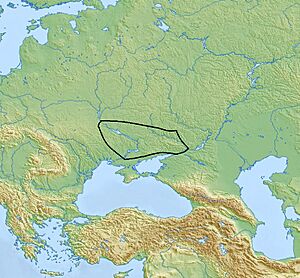Sredny Stog culture facts for kids
 |
|
| Geographical range | Ukraine, Russia |
|---|---|
| Period | Chalcolithic Europe |
| Dates | c. 4500 BC – 3500 BC |
| Preceded by | Dnieper-Donets culture |
| Followed by | Cernavodă culture, Repin culture, Suvorovo culture, Novodanilovka group |
The Sredny Stog culture was an ancient group of people who lived a very long time ago, between about 4500 BC and 3500 BC. We call them an 'archaeological culture' because we learn about them from the tools, pottery, and other things they left behind. This culture is named after a small island called Serednii Stih (or Sredny Stog) in the Dnieper River in Ukraine, where their remains were first found.
Contents
Where They Lived
The Sredny Stog people mainly lived along the Dnieper River in what is now Ukraine. They had settlements along the riverbanks, and some smaller groups lived a bit further west and east.
They likely traded or interacted with other ancient cultures. To their west, they met the Cucuteni–Trypillian culture, who were farmers living in modern-day Moldova, Romania, and Ukraine. To their northeast, they were neighbors with the Khvalynsk culture, who lived near the Volga River.
Important Places They Lived
One of the most important places linked to the Sredny Stog culture is a site called Deriivka. It's located on the Omelnik River, which flows into the Dnieper. Deriivka is the largest known Sredny Stog site, covering about 2,000 square meters. It includes both a settlement where people lived and a cemetery where they buried their dead.
Other important Sredny Stog sites include Igren-8 and Moliukhiv Buhor, both on the Dnieper River. There's also Oleksandriia, located on the Oskil River in eastern Ukraine.
How They Lived
The Sredny Stog people moved around quite a bit. This is why their settlements were often simple. Their homes were usually basic, rectangular buildings that were not meant to be permanent.
Experts have divided the Sredny Stog culture into two main time periods:
- Phase I (around 4500 BC): During this time, their pottery did not have special cord patterns.
- Phase II (late 4000s BC to early 3000s BC): In this later phase, they started making pottery with patterns that looked like they were made by pressing cords into the clay. This type of pottery is called "corded ware" and became common in other cultures later on. They also used stone battle-axes.
One of the most exciting discoveries from the Sredny Stog culture is some of the earliest evidence that people might have started taming horses. They found items that look like parts of a horse's bridle, which would have been used to control them. However, we don't have clear proof that these horses were ridden. They might have been used more for getting food.
How They Buried Their Dead
In their largest cemeteries, like Oleksandriia, Igren, and Deriivka II, archaeologists found that the Sredny Stog people buried their dead in flat graves. These were pits dug directly into the ground. This was different from later cultures, like the Yamnaya culture, who buried their dead under large mounds called kurgans.
The Sredny Stog people usually placed the deceased on their backs with their legs bent. They also used a red mineral called ochre in the burials. This practice was also common in later kurgan cultures.
Their Language and People
Some experts believe that the Sredny Stog culture might be where the Proto-Indo-European language began. This is the ancient language from which many modern languages, like English, Spanish, and Hindi, developed. Other theories suggest different origins for this language family.
Scientists have studied the bones of Sredny Stog people. They found that these people were of a physical type called "Europoid." They were generally tall and strongly built. This is similar to the people of the later Yamnaya culture.
Their DNA Story
Scientists have studied the DNA from ancient Sredny Stog individuals. One male from Oleksandriia, dating to around 4153-3970 BC, had a specific Y-DNA marker called R1a1a1 and a mitochondrial DNA marker called H2a1a. His DNA showed that he had a mix of about 80% "Western Steppe Herder" (WSH) ancestry and 20% "Early European Farmer" (EEF) ancestry. This was one of the first times EEF ancestry was found in someone from the steppe region.
Another Sredny Stog individual from Deriivka II, from around 4320-4052 BC, showed that about one-third of their DNA came from local people of the Dnieper Valley, and the rest was from the steppe, similar to the Yamnaya.
The "Western Steppe Herder" (WSH) DNA found in the Sredny Stog culture is similar to that found in the Khvalynsk culture. These genetic studies help us understand how different ancient groups mixed and moved across Europe.
What Came After Them
The Sredny Stog culture ended around 3500 BC. At this time, the Yamnaya culture began to spread westward. The Yamnaya people replaced the Sredny Stog culture and came into direct contact with the Cucuteni–Trypillia culture in western Ukraine.
Sources
- J. P. Mallory, "Sredny Stog Culture", Encyclopedia of Indo-European Culture, Fitzroy Dearborn, 1997.

